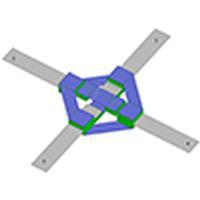当前位置:
X-MOL 学术
›
Opt. Express
›
论文详情
Our official English website, www.x-mol.net, welcomes your feedback! (Note: you will need to create a separate account there.)
Frequency conversion and parametric amplification using a virtually rotating metasurface
Optics Express ( IF 3.8 ) Pub Date : 2020-02-19 , DOI: 10.1364/oe.384467 Zohreh Seyedrezaei , Behzad Rejaei , Mohammad Memarian
Optics Express ( IF 3.8 ) Pub Date : 2020-02-19 , DOI: 10.1364/oe.384467 Zohreh Seyedrezaei , Behzad Rejaei , Mohammad Memarian

|
We analyze the scattering of circularly polarized electromagnetic waves from a time-varying metasurface having a time-dependent surface susceptibility that locally mimics a rotating, anisotropic surface. Such virtually rotating metasurfaces (VRM) can be realized by means of electronically tunable surface elements and reach microwave-range rotation frequencies. It is shown that the scattered field contains the incident tone, as well as a single up-or down converted tone which differs by twice the rotation frequency of the surface. A simple full frequency converter is then proposed by augmenting the VRM with a metal screen separated by a proper distance. It is shown that after reflection from this system, the incident tone is fully converted to a single down- or up-converted tone, and shows amplification in the case of up conversion. The analysis of these time-rotating scenarios is carried out by switching to a rotating frame for the fields, leading to time-invariant equations, and thus using common phasor-representation. All results are also validated against an in-house 1D-FDTD code showing excellent agreement. A lumped element model using a 2D periodic metal mesh grid loaded with time-varying capacitive nodes is also presented that enables the VRM concept. This model is then further used to design a 3D realization, verified with static full-wave simulations for different values of the capacitor arrangement. Furthermore, the effect of piece-wise constant changes of surface susceptibility in a general virtually rotating metasurface is studied and it is shown to operate with acceptable results, which is of practical importance. The results of this paper can open new ways for realization of frequency conversion and amplification, in a magnetless and linear time-varying system.
中文翻译:

使用几乎旋转的超表面进行频率转换和参数放大
我们分析了来自时变的超表面的圆极化电磁波的散射,该表面具有随时间变化的表面磁化率,该磁化率局部模拟旋转的各向异性表面。这种虚拟旋转的超表面(VRM)可以通过电子可调表面元件来实现,并达到微波范围的旋转频率。结果表明,散射场包含入射声调,以及一个上/下变换声调,其相差表面旋转频率的两倍。然后提出了一种简单的全变频器,它是通过以适当距离分隔开的金属丝网来增强VRM来实现的。示出了在从该系统反射之后,入射音被完全转换为单个下转换或上转换的音,并且在上转换的情况下示出放大。这些时间旋转方案的分析是通过切换到该字段的旋转框架,导致时间不变方程式并因此使用公共相量表示来进行的。所有结果也都通过内部1D-FDTD代码验证,显示出极好的一致性。还提出了使用带有时变电容性节点的2D周期性金属网格网格的集总元素模型,该模型启用了VRM概念。然后,该模型可进一步用于设计3D实现,并通过静态全波仿真对电容器布置的不同值进行验证。此外,研究了在一般虚拟旋转的超颖表面中表面磁化系数的逐段恒定变化的影响,并证明该方法能以可接受的结果运行,这具有实际意义。本文的结果为在无磁线性时变系统中实现频率转换和放大开辟了新的途径。还提出了使用带有时变电容性节点的2D周期性金属网格网格的集总元素模型,该模型启用了VRM概念。然后,该模型可进一步用于设计3D实现,并通过静态全波仿真对电容器布置的不同值进行验证。此外,研究了在一般虚拟旋转的超颖表面中表面磁化率的逐段恒定变化的影响,并证明该方法能以可接受的结果运行,这具有实际意义。本文的结果为在无磁线性时变系统中实现频率转换和放大开辟了新的途径。还提出了使用带有时变电容性节点的2D周期性金属网格网格的集总元素模型,该模型启用了VRM概念。然后,该模型可进一步用于设计3D实现,并通过静态全波仿真对电容器布置的不同值进行验证。此外,研究了在一般虚拟旋转的超颖表面中表面磁化系数的逐段恒定变化的影响,并证明该方法能以可接受的结果运行,这具有实际意义。本文的结果为在无磁线性时变系统中实现频率转换和放大开辟了新的途径。通过静态全波仿真对电容器布置的不同值进行了验证。此外,研究了在一般虚拟旋转的超颖表面中表面磁化系数的逐段恒定变化的影响,并证明该方法能以可接受的结果运行,这具有实际意义。本文的结果为在无磁线性时变系统中实现频率转换和放大开辟了新的途径。通过静态全波仿真对电容器布置的不同值进行了验证。此外,研究了在一般虚拟旋转的超颖表面中表面磁化系数的逐段恒定变化的影响,并证明该方法能以可接受的结果运行,这具有实际意义。本文的结果为在无磁线性时变系统中实现频率转换和放大开辟了新的途径。
更新日期:2020-03-02
中文翻译:

使用几乎旋转的超表面进行频率转换和参数放大
我们分析了来自时变的超表面的圆极化电磁波的散射,该表面具有随时间变化的表面磁化率,该磁化率局部模拟旋转的各向异性表面。这种虚拟旋转的超表面(VRM)可以通过电子可调表面元件来实现,并达到微波范围的旋转频率。结果表明,散射场包含入射声调,以及一个上/下变换声调,其相差表面旋转频率的两倍。然后提出了一种简单的全变频器,它是通过以适当距离分隔开的金属丝网来增强VRM来实现的。示出了在从该系统反射之后,入射音被完全转换为单个下转换或上转换的音,并且在上转换的情况下示出放大。这些时间旋转方案的分析是通过切换到该字段的旋转框架,导致时间不变方程式并因此使用公共相量表示来进行的。所有结果也都通过内部1D-FDTD代码验证,显示出极好的一致性。还提出了使用带有时变电容性节点的2D周期性金属网格网格的集总元素模型,该模型启用了VRM概念。然后,该模型可进一步用于设计3D实现,并通过静态全波仿真对电容器布置的不同值进行验证。此外,研究了在一般虚拟旋转的超颖表面中表面磁化系数的逐段恒定变化的影响,并证明该方法能以可接受的结果运行,这具有实际意义。本文的结果为在无磁线性时变系统中实现频率转换和放大开辟了新的途径。还提出了使用带有时变电容性节点的2D周期性金属网格网格的集总元素模型,该模型启用了VRM概念。然后,该模型可进一步用于设计3D实现,并通过静态全波仿真对电容器布置的不同值进行验证。此外,研究了在一般虚拟旋转的超颖表面中表面磁化率的逐段恒定变化的影响,并证明该方法能以可接受的结果运行,这具有实际意义。本文的结果为在无磁线性时变系统中实现频率转换和放大开辟了新的途径。还提出了使用带有时变电容性节点的2D周期性金属网格网格的集总元素模型,该模型启用了VRM概念。然后,该模型可进一步用于设计3D实现,并通过静态全波仿真对电容器布置的不同值进行验证。此外,研究了在一般虚拟旋转的超颖表面中表面磁化系数的逐段恒定变化的影响,并证明该方法能以可接受的结果运行,这具有实际意义。本文的结果为在无磁线性时变系统中实现频率转换和放大开辟了新的途径。通过静态全波仿真对电容器布置的不同值进行了验证。此外,研究了在一般虚拟旋转的超颖表面中表面磁化系数的逐段恒定变化的影响,并证明该方法能以可接受的结果运行,这具有实际意义。本文的结果为在无磁线性时变系统中实现频率转换和放大开辟了新的途径。通过静态全波仿真对电容器布置的不同值进行了验证。此外,研究了在一般虚拟旋转的超颖表面中表面磁化系数的逐段恒定变化的影响,并证明该方法能以可接受的结果运行,这具有实际意义。本文的结果为在无磁线性时变系统中实现频率转换和放大开辟了新的途径。


























 京公网安备 11010802027423号
京公网安备 11010802027423号